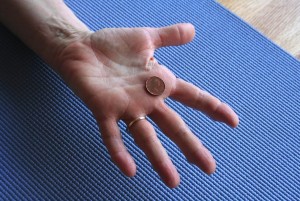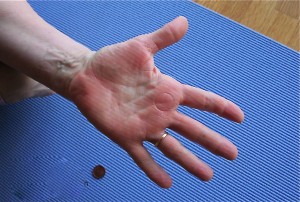
Place a penny between your index and middle finger mounds
My friend Terri told me recently that she’d had a pain in her foot that was given temporary relief whenever she did downward facing dog pose.
So she found herself doing dog pose five or more times a day – whenever the pain-relieving effect wore off.
“You know the interesting thing?” she said. “They started feeling different as the day went on. I started noticing things.”
Ah, dog pose.
It strengthens, it stretches, it wakes us up, it calms us down.
Here’s a slightly condensed version of the effects for Adho Mukha Svanasana as given in Light on Yoga:
When one is exhausted, a longer stay in this pose removes fatigue and brings back the lost energy. . . . The pose relieves pain and stiffness in the heels and helps to soften calcaneal spurs. It strengthens the ankles and makes the legs shapely.
The practice of this asana helps to eradicate stiffness in the region of the shoulder-blades and arthritis of the shoulder hjoints is relieved. The abdominal muscles are drawn towards the spine and strengthened. As the diaphragm is lifted to the chest cavity the rate of the heart beat is slowed down.
This is an exhilarating pose. . . . As the trunk is lowered in this asana it is fully stretched and healthy blood is brought to this region without any strain on the heart. It rejuvenates the brain cells and invigorates the brain by relieving fatigue.
With so many benefits, how could it possibly not have as many adjustments, and in Iyengar yoga, as many possible propping variations? And how could you not help noticing things as you practice it?
This week’s Five-Minute Yoga Challenge is to spend five minutes a day in Adho Mukha Svanasana, downward facing dog.
You might choose to put your heels on the wall and a wood brick under your head, and stay for five minutes. Or you might break it up into five one-minute holdings, or two holdings of a two-and-a-half minutes. You could try the same propping every time, or vary it.
All that matters is that you do the pose, and pay attention to how it feels as you do it.
If it’s giving you wrist pain just to think about five minutes of downward dog in a day, here’s something to try.
You can, of course, put your hands on bricks at the wall, or do your dog pose with the support of a chair. But by learning where to place the weight in your hands while you’re in the pose, you can begin to come to a permanent solution for sore wrists.
With your right index finger, find the spot between your index and middle finger mounds. Now take a penny and press it into that space.

The proof of the penny: look for a nice clear imprint
Holding the penny in place, turn your palm down and position it for downward facing dog pose.
Place your second hand on the mat, and take the pose.
(if you have a yoga buddy nearby, you can do both hands at once. Position the pennies and get your helper to hold them in place as you flip your hands over.)
Press down into your finger mounds. Extend your fingers. Stretch your thumbs towards each other. Now press into the penny.
Of course, at the same time: take your thighs, shins and ankles back. Lift your outer hips, and as you bring your heels toward the floor, lift your inner ankles.
After a minute or two, come down, turn your hand over, and look at the indentation. Ideally, you have a perfect circle.
If the line is heavier on the little finger side, you need to bring more weight to the thumb side of your hand.
Try it again, and see if you can even out the circle.
Benefits: Check an anatomy book and you’ll see that the radius, the thicker and heavier of the two forearm bones, connects to the thumb side of your hand. When you bring your weight into the finger mounds toward the thumb side, you’re placing it on the side that’s designed to bear it. You’ll reduce strain in your wrists, gain more strength in the pose, and be better able to lengthen your inner arms and move your shoulder blades away from your ears.
Sequence: Try it once, and if your results aren’t stellar, repeat the penny test several practices in a row. Tune into the feeling of pushing evenly down on both sides of the penny, then duplicate that feeling in every downward facing dog that you do.
Ouch: If your shoulders are very tight, you may not be able to keep your arms straight with weight in your index finger mounds. Ask your teacher to show you a variation of downward dog that you can perform with straight arms – perhaps with your hands to a chair seat, or your fingers turned out to the side.
Sanskrit Corner: Say AH-doh MOO-kah shvah-NAH-sanna. Adho means downward. Mukha means face. Svanna means dog, and asana means pose.
Do you have shaggy dog tales? Discoveries in practice? Ways of relieving your wrists in downward dog? I’d love to hear about them.




Comments on this entry are closed.
I am loving yoga! The only problem after downward facing dog I get muscular pains inbetween my shoulders blades. I asked one of my teachers about it and she said that I am turning my arms in too much and that I need to rotate them externally. I am finding this almost impossible to do. Any tips? thanks
Hi Ali,
Glad to know you are loving yoga.
It’s hard to know without seeing you what your downward dog problem might be. But if your teacher thinks it’s arms too inwardly rotated, let’s go with that.
One easy way to externally rotate your upper arms is to turn your hands out when you do the pose, so your fingers point to the outside of your mat. In that position, you’ll find it much easier to make the rotation. Once you know how to do it, you can gradually bring your hands back to the classic position.
I hope that helps.
JUST yummy! LOVE downward dog.
Heidi